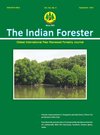Seed Germination Behavior in Garcinia imberti Bourd
DOI:
https://doi.org/10.36808/if/2016/v142i9/54732Keywords:
Dormancy, Garcinia imberti, Germination.Abstract
Garcinia imberti is an endemic tree of the southern Western Ghats endangered due to dwindling population and restricted distribution. At natural conditions, seeds poorly germinate and are also prone to high rate of predation. This study was carried out to investigate germination responses of both immature and mature Garcinia imberti seeds and their parts. Seeds were cut in to different parts with proximal section (PS), distal section (DS), proximal end chipped off (PEC), proximal and distal ends chipped off (PDEC) before being experimented with decoated seeds (DS) against raw seeds as control (C). The results showed significant increase of germination percentage in both immature and mature decoated seeds. Data on germination speed, seed vigour index and seedling length also favoured seed decoating treatment. The present study provided cues on seed coat imposed dormancy and survivability of sliced seeds.References
Abdul-Baki A.A. and Anderson J.D. (1973). Vigour determination in soybean by multiple criteria. Crop Science, 10: 31 - 34.
Anegbeh P.O., Iruka C. and Nkirika C. (2006). Enhancing germination of bitter cola (Garcinia kola) Heckel: prospects for agroforestry farmers in the Niger Delta. Scientia Africana, 5 (1): 1118 - 1931.
Ahmedullah M. and Nayar M.P. (1986). Endemic plants of the Indian Region, Vol. 1. Botanical Survey of India, Calcutta. p. 76.
Anilkumar C., Babu K.P. and Krishnan P.N. (2002). Dormancy mechanism and effects of treatments on the germination of Garcinia gummigutta (Clusiaceae) seeds. J. Tropical Forest Science, 14 (3): 322- 328.
Asomaning J.M., Olympio N.S. and Sacande S. (2011). Desiccation sensitivity and germination of recalcitrant Garcinia kola Heckel seeds. Research J. Seed Science, 4 (1): 15- 27.
Basra A.S. (1994). Mechanisms of plant growth and improved productivity: Modern approaches. CRC press, New York, 476.
Bourdillon T.F. (1898). Description of some new or rare trees from Travancore. J. Bomb. Nat. Hist. Soc., 12:349.
Chacko K.C. and Pillai P.K.C. (1997). Seed characteristics and germination of Garcinia gummi gutta (L.) Robs. Indian Forester,72: 123- 126.
Czabator F.J. (1962). Germination value: An index combining speed and completeness of pine seed germination. Forest Science, 8: 386 – 395.
Ellis R.H. and Roberts E.H. (1981). The quantification of ageing and survival in orthodox seeds. Seed Science and Technology, 9: 373- 409.
George G.L., Lakshmanan R., Mathew K.M. and Y.S. Rao (2002). Review of research on kokum, camboge and related species. Journal of Spices and Aromatic Crops, 11: 1- 12.
ISTA (2008). International rules for seed testing association, News Bulletin, Seed Science and Technology, 135: 31- 33.
ISTA (1993). International rules for seed testing, Rules 1993.Annexe to chapter 5. Seed Science and Technology, 21 (Supplement): 141- 186.
IUCN (2013). Garcinia imberti. The IUCN Red List of Threatened Species. Version 2013.2. downloaded on 22 June 2014.
Joseph A., Satheeshan K.N. and T.G. Jomy (2007). Seed germination studies in Garcinia spp. J. Spices and Aromatic Crops, 16 (2): 118- 121.
Joshi G., Kumar A.N.A., Gowda B. and Srinivasa Y.B. (2006). Production of supernumerary plants from seed fragments of Garcinia gummigutta: evolutionary implications of mammalian frugivory. Current Science, 91: 372- 376.
KAU (2001).Three Decades of Spices Research at KAU. Kerala Agricultural University, Thrissur.
Maheshswari J.K. (1964). Taxonomic studies on Indian Guttiferae III. The genus Garcinia L. Bull. Bot. Survey India, 6: 107- 135.
Mohanan N., Shaju T, Rajkumar G. and Pandurangan A.G. (1997). Rediscovery of Garcinia imberti Bourd. (Clusiaceae), A little known endemic species of Western Ghats. Indian J. Forestry,20 (4): 383- 385.
Mohan S., Parthasarathy U. and Nirmalbabu K. (2012). In vitroand in vivo adventitious bud differentiation from mature seeds of three Garcinia spp. Indian J. Nat. Products and Resources, 3(1): 65- 72.
Morton J. (1987). Mangosteen (Garcinia mangostana L.). In: Fruits of warm climates, Morton, J.F., (Ed). Creative Resources Systems, Inc., Miami, FL., Winterville, pp: 301- 304.
Normah M.N., Ramiya S.D. and Gintangga M. (1997). Desiccation sensitivity of recalcitrant seeds- a study on tropical fruit species. Seed Science Research, 7: 179- 183.
Rameshkumar K.B., Shiburaj S. and V. George (2005). Constituents and antibacterial activity of the stem bark oil of Garcinia imberti. Tropical Medicinal Plants, 6: 271- 273.
Richards A.J. (1990). Studies in Garcinia, dioecious tropical forest trees, Agamospermy. Bot J. Linn Soc., 103: 233– 250.
Vazquez-YanesC.andA.Orozco-Segovia(1993).Pattern ofseed longevityandgerminationin thetropical rain forest.Ann.Rev.Ecol.Sys.,24:69-68.
Downloads
Downloads
Published
How to Cite
Issue
Section
License
Unless otherwise stated, copyright or similar rights in all materials presented on the site, including graphical images, are owned by Indian Forester.





